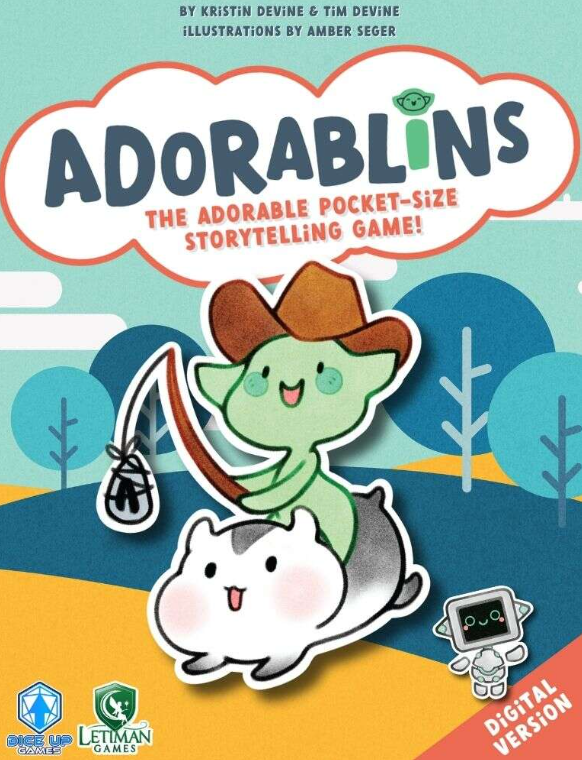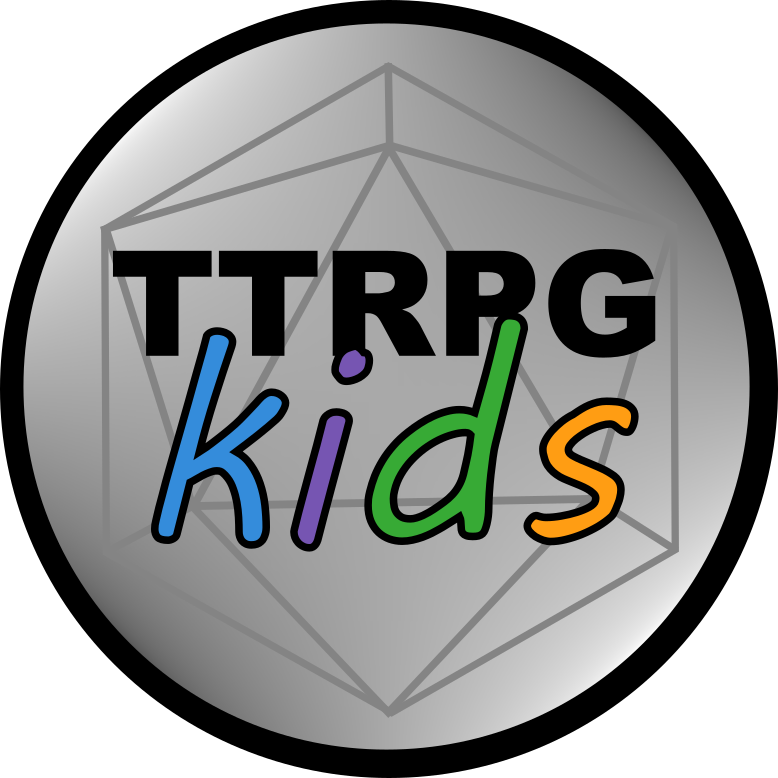Interview with Kristin and Tim, creators of Adorablins!
Note: this is a transcripted interview, edited for ease of reading
Note: This post may contain affiliate links. At no additional cost to you, I may earn a small commission from purchases made using them. TTRPGkids uses this to keep the site going. Read full disclosure here.
Jump to:
- Introductions
- Your TTRPG experience
- Favorite TTRPG moments
- Playing TTRPG’s with kids
- What is Adorablins?
- Unique features of Adorablins
- Tips for bringing TTRPG’s to kids
Can you tell us a bit about yourselves?
Kristin: I am a tabletop role playing game designer, writer, podcaster, and live streamer. I really enjoy the indie role playing game space and doing everything I can to be part of that.
Tim: I am partners with Kristin, and I also write, design, and play a lot role-playing games, mostly indie tabletop games.
What has your tabletop RPG experience been like?
Tim: I’ve been playing role-playing games – I’m 38, and I’ve been role-playing since I was 9, so… a lot of years with a big huge chunk of a break in the middle. I started when I was very young with my cousins playing Westend’s Star Wars game, and it was also the first system that I hacked into something else. From there, I just played all kinds of different stuff.
Kristin: I did not start as early. I grew up in the very real satanic panic times, so I was not allowed to play D&D. I started in my very early 20’s, so almost 20 years ago – I’ve been role-playing for a while!
Tim: If you’ve started role-playing in the past 10 years, there’s been so many more games. There’s been so much spotlight, and it’s been so much more popular. Starting now is like the equivalent of running for 15 years; it’s the golden age.
What was one of your favorite tabletop RPG moments?
Kristin: I don’t know how to narrow it down to one! I’ve been lucky enough to play quite a few games, mostly due to the podcasts and live streams that I’m part of. It is very hard to narrow down.
I am a baby GM. I have only GM’d a handful of times and only in the last 15 months. My favorite is… the first time I ran a game of Blades in the Dark (which is one of my all-time favorite systems) – it was not a specific moment in that game so much as I learned the system, I did it, and everyone seemed to have a great time. It was a really positive experience for me!
It’s a completely different skill than everything else – from design to writing to playing, it’s just different!
Tim: I’ve played in a lot of games and I’ve run a lot of games, some that have spanned years, and there’s so many good moments! The first thing that jumps into my head was as a spectator though.
The first time I saw a live stream of someone else playing a game that we made was AMAZING. They played Truth and Daring, which is a hack of Lasers and Feelings. All the cast members dressed up, they were all in character, and there was a sing-a-long in the game! Sure, they’re all awesome and probably would have had fun whatever they were playing, but… it was our game they were playing! It made what we were doing make more sense to me.
Can you tell us about playing tabletop RPGs with your kids?
Tim: When our son was 2-ish, we gamified life with our son. The first game we played with him was with his legos. We made a town and everyone in the town had a problem that correlated to a brick that was a certain color for sad, mad, etc. And if you got enough bricks, it built a bridge to get across the water to fight the dragon. It was such a simple thing and took no time, but it had such an impact. There was a desire there to do this type of thing and introduce more role-play.
What can you tell us about Adorablins?

Tim: The core system that we made, we made for our family, not even thinking it would be something we would bring to publishing. It was meant to be a streamlined, stripped down version of a Powered by the Apocalypse (PbtA) game for our then 3.5 year old son. This really worked – it worked so well mainly because it has minimal set up, everything is right there, it cleans up easily, and it just makes sense to younger kids. We knew we had something then, but we didn’t really know what to do with it because we had other games we were making.
Then, as we played more with our son and other younger players and met more people in the past, we realized, there are a lot of other interested parents out there. There are a lot of good games for kids out there too. We wanted to go into sort of a fantasy themed setting. Then we connected with Questlings which is a game by Letiman games and Game and Curry Banana. Banana Chan, who is a friend of ours, looped me into that project, so I got to co-design a kids game, which is a fantasy themed kid’s game, so now we really can’t release our game.
Then, we met up with another friend of ours, Amber, they do really cute art with that Paper Mario feel to it. We thought… there’s got to be something there. Let’s make it a very whimsical, light, easy way to play a fun game using this system. It worked so well, and we all worked so well together that it shifted into where we’re going now for Adorablins. It’s going to be a pocket-sized, mint-tin, role-playing game all contained in an easy and portable container.
There’s a lot of really amazing kid-friendly role-playing systems, so we focused on finding the little unique parts that those ones don’t have or work well for us and for other people.
What are some unique features of Adorablins?
Kristin: Amber draws goblins, but the art for this game is unique to the game, and because of that, we came up with a bit of the goblin lore, the world, the backstory. That’s unique because it was based on her vision and her art.
As far as mechanics, I think the fact that it’s introducing young kids to a PbtA 2d6 system without the playbooks and special moves that come with most PbtA games is unique. I love them [the playbooks and special moves], and they’re great, but that’s pretty difficult for really young kids.
What I also really like about our game is that we really have played it with kids, and it was fun. We’ve also playtested it with many adults. It becomes very light-hearted, silly, and improv heavy, and it works super well for adults, in addition to kids.
Tim: For kids, it’s that entry level stepping stone into PbtA narrative, which is neat because any terms that get thrown at them can be built on top of. The roll and having 3-tiered successes, they’ll get that later.
There’s also how we wanted to present it to people through custom cards. You don’t need a big book at the table – everything is on the cards and in the tin. There’s narrator cards that tell you what to do. While you’re explaining the game to everyone, you’re in the game already. You pick your character cards, you pick your little companion to go along with you, you pick a dice rolling card, and that’s all you need. You’re ready to play the game.
It also fits any time you have. If you have 20 minutes before dinner, you can play a quick game of Adorablins! If you have a full 2 hours, you can play it. If you’re at a convention and you don’t want to get out a bunch of paper and pencils, you can pull this out and play it for 20-30 minutes.
Kristin: We also have two cards that I think are really important.
One is the safety card, the X card. I’ll be clear, we did not invent it, we just added it. I think that teaching kids about using their voice and speaking up when things are uncomfortable is really important. So is paying attention to what other people at the table are feeling.
The other is the spotlight card, which adults may not need, but it helps children to take turns and be able to speak.
What are some tips that you would give to parents, teachers, caregivers, etc who are thinking about starting tabletop RPGs with kids?
Tim: I would say finding something they’re already interested in is important, and if you can’t find a game that fits that interest, make another game fit it. You’re going to have a lot more success if they’re into it versus trying to get them to like a genre that they’re not that familiar with.
Kristin: Try a couple of different games to help develop their playstyle to see how they prefer to play. See what aspects of the game they’re drawn to.
Tim: Playing role-playing games with kids is awesome in a lot of ways. Each time you play and each kid that plays it – you see a different skill or interest develop. From my personal history, I did not do well in school, and I did not like to read… but I would consume role-playing books. I would read a role-playing book like it was a text book or instructions, but I wouldn’t read any of the books the school would give me. It’s amazing how much this appeals to kids. Opening it up to them is going to possibly help them out in a lot of areas that you weren’t expecting.
Kristin: We have experience with children that have very complex emotions and did not have words for those complex emotions at a young age, and role-playing was key for us to help work through problems and give words and show that other people have emotions. I would encourage any parent who is currently dealing with wonderfully complex emotional children to try role-playing games.
Thank you Tim and Kristin for your time and doing the interview!
I also wrote a review of Adorablins here, you can find the Adorablins digital version here, and go check out everything that Tim and Kristin are doing over at Dice Up Games (including Adorablins physical copies) here!
If you liked this post, make sure to subscribe to the TTRPGkids monthly newsletter to stay up to date on the latest reviews, tips and tricks, game and podcast list updates, and more! Thank you for playing tabletop RPGs with your kids and sharing this awesome hobby with the next generation!



5 thoughts on “Interview with Kristin and Tim, creators of Adorablins!”